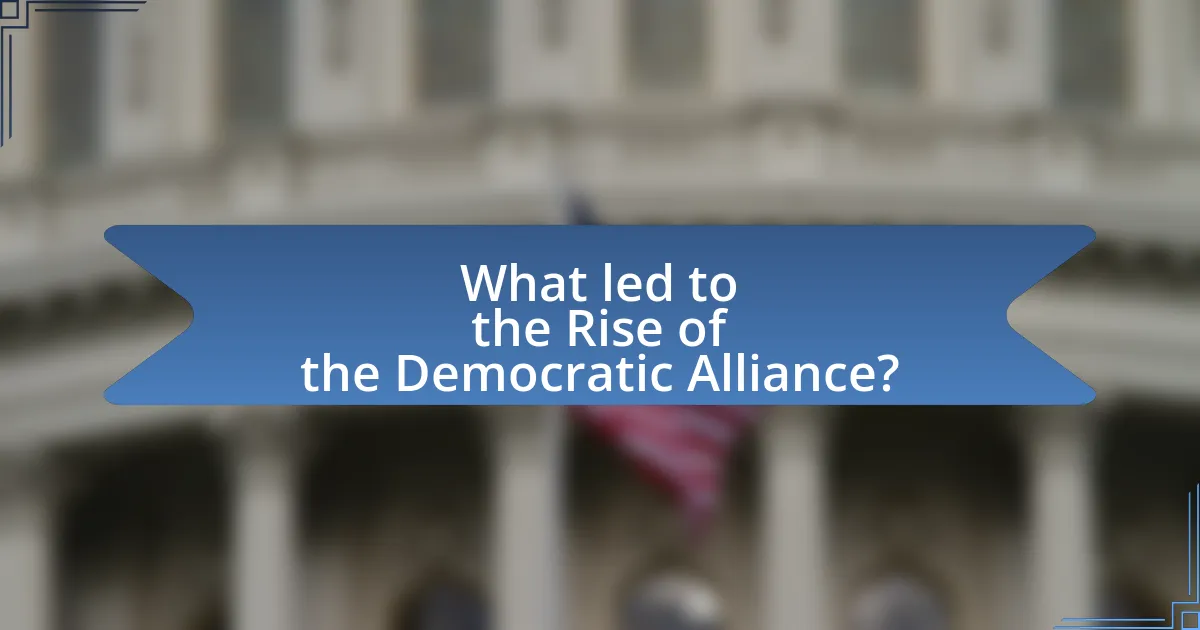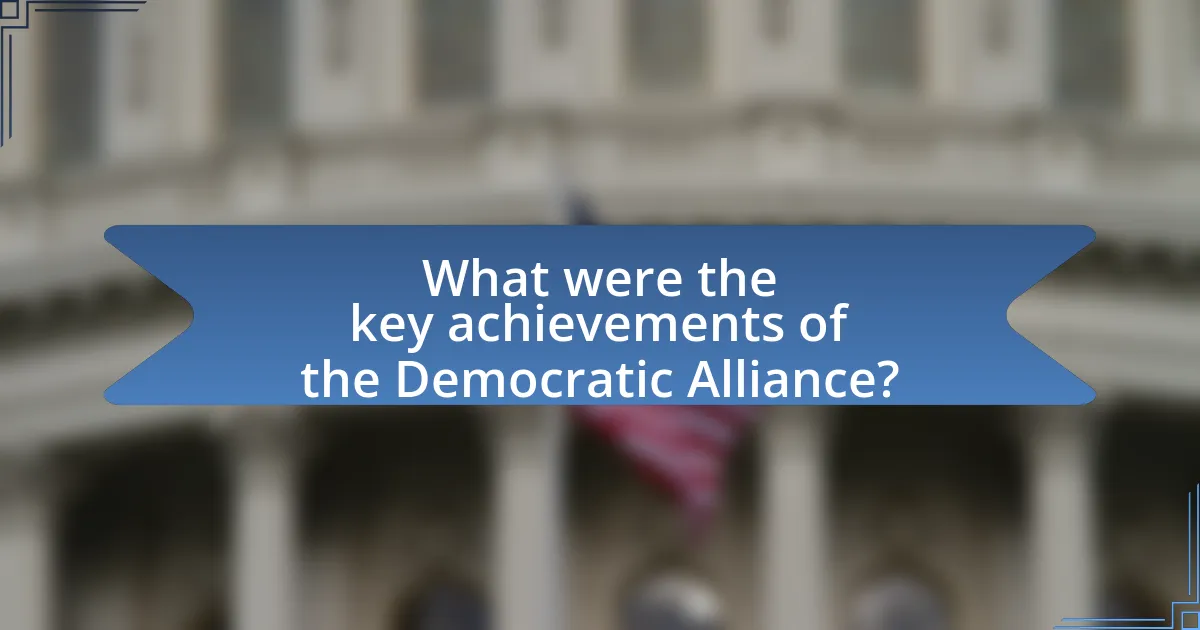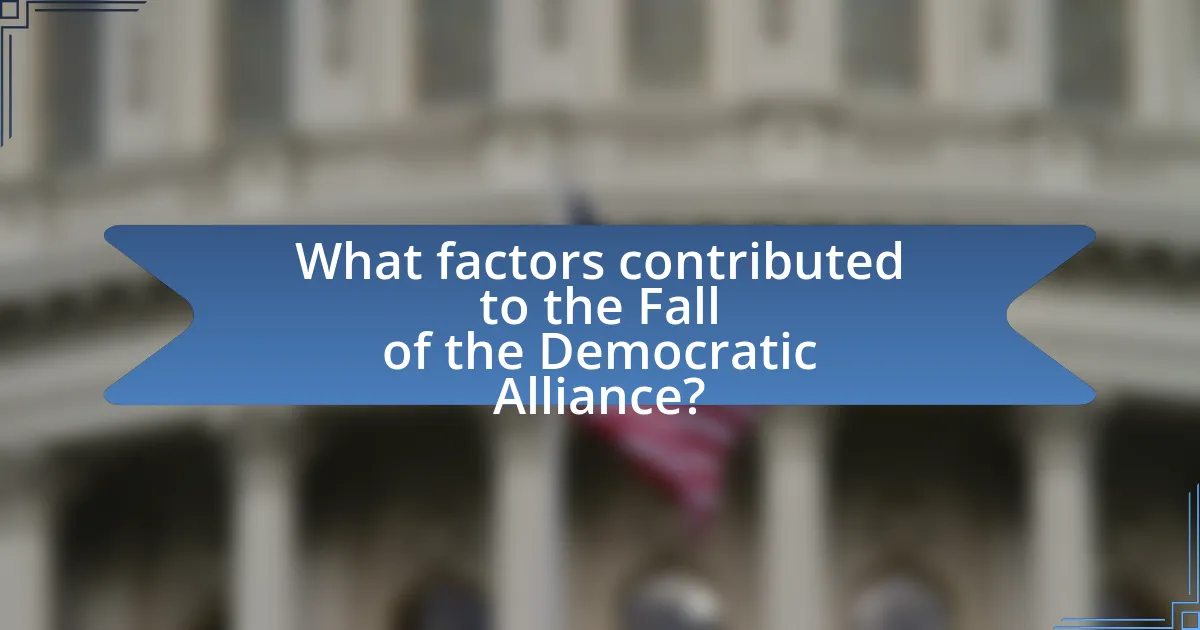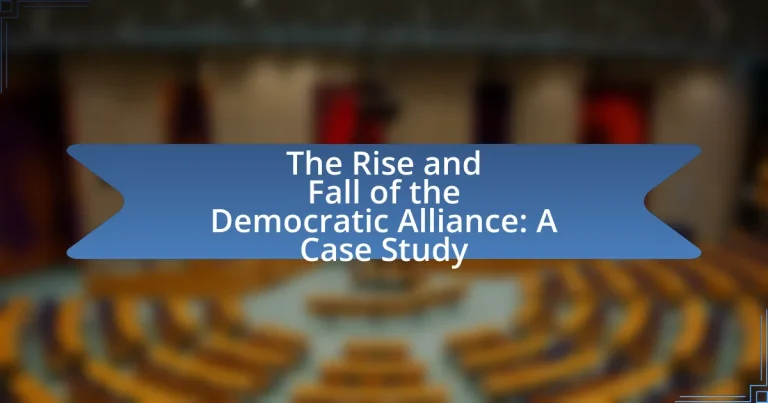The Democratic Alliance (DA) is a significant political party in South Africa that emerged as a viable alternative to the African National Congress (ANC) following growing public discontent with the ANC’s governance. The article examines the DA’s rise, highlighting its strategic positioning, key leadership figures, and successful electoral strategies that led to increased support in national elections. It also addresses the challenges the party faced, including internal conflicts, shifting voter demographics, and competition from other political entities, which contributed to its decline. The analysis concludes with insights into the DA’s current status and prospects for future elections, emphasizing the importance of effective governance and coalition-building in maintaining political relevance.

What led to the Rise of the Democratic Alliance?
The rise of the Democratic Alliance was primarily driven by its strategic positioning as a viable alternative to the African National Congress in South African politics. This shift occurred due to growing public discontent with the ANC’s governance, particularly regarding issues like corruption, service delivery failures, and economic challenges. The Democratic Alliance capitalized on these sentiments by promoting a platform focused on good governance, accountability, and economic reform, which resonated with a significant portion of the electorate. In the 2014 national elections, the Democratic Alliance increased its support to 22.2% of the vote, reflecting its successful appeal to disillusioned voters seeking change.
How did the Democratic Alliance establish itself in South African politics?
The Democratic Alliance established itself in South African politics by positioning itself as a viable alternative to the African National Congress, particularly after the end of apartheid in 1994. The party, originally formed in 2000 through a merger of several opposition parties, gained traction by advocating for liberal democratic values, economic reform, and anti-corruption measures. Its significant breakthrough came in the 2014 national elections, where it secured 22% of the vote, demonstrating its growing support among voters disillusioned with the ruling party. The DA’s success in various provincial elections, particularly in the Western Cape, further solidified its presence, allowing it to govern in coalition with other parties and expand its influence across the country.
What key events contributed to the formation of the Democratic Alliance?
The formation of the Democratic Alliance was primarily influenced by the merger of the Democratic Party and the New National Party in 2000, which aimed to create a unified opposition to the African National Congress. This strategic alliance was driven by the need to consolidate opposition forces in South Africa’s political landscape, particularly after the 1999 elections, where the Democratic Party sought to increase its electoral strength. The Democratic Alliance’s establishment was further solidified by the party’s commitment to liberal democratic values and its focus on issues such as governance, accountability, and service delivery, which resonated with a significant portion of the electorate.
Who were the influential leaders in the early years of the Democratic Alliance?
The influential leaders in the early years of the Democratic Alliance were Tony Leon, who served as the party leader from 1999 to 2007, and Helen Zille, who succeeded him and led from 2007 to 2015. Tony Leon played a crucial role in transforming the party into a significant opposition force in South Africa, particularly during the 1999 elections when the DA increased its parliamentary representation. Helen Zille further solidified the party’s position, notably winning the Western Cape province in the 2009 elections, which marked a significant milestone for the DA.
What strategies did the Democratic Alliance employ to gain support?
The Democratic Alliance employed several strategies to gain support, including a focus on coalition-building, effective communication, and policy innovation. Coalition-building allowed the party to unite various opposition groups, enhancing its electoral strength, as seen in the 2016 local elections where it formed a coalition in key municipalities. Effective communication strategies, such as targeted social media campaigns, helped the party engage younger voters and articulate its vision clearly. Additionally, the Democratic Alliance emphasized policy innovation by addressing issues like corruption and service delivery, which resonated with voters seeking accountability and improved governance. These strategies collectively contributed to the party’s growth and increased electoral support in South Africa.
How did the Democratic Alliance appeal to diverse voter demographics?
The Democratic Alliance appealed to diverse voter demographics by promoting a platform centered on non-racialism, economic opportunity, and effective governance. This approach attracted voters from various racial and socio-economic backgrounds, particularly in urban areas. For instance, the party’s focus on service delivery and anti-corruption resonated with middle-class voters, while its commitment to social justice and equality appealed to historically marginalized communities. In the 2019 elections, the Democratic Alliance garnered approximately 22% of the national vote, reflecting its ability to connect with a broad spectrum of the electorate, including significant support from black voters in metropolitan regions.
What role did policy positions play in the Democratic Alliance’s rise?
Policy positions were crucial in the Democratic Alliance’s rise, as they differentiated the party from its competitors and attracted a diverse voter base. The Democratic Alliance adopted a platform emphasizing good governance, anti-corruption, and economic reform, which resonated with voters disillusioned by the ruling party’s failures. For instance, their commitment to service delivery and accountability helped them gain significant support in urban areas, leading to increased electoral success, such as winning control of major municipalities like Cape Town in 2006. This strategic focus on policy not only enhanced their credibility but also positioned them as a viable alternative in South African politics.

What were the key achievements of the Democratic Alliance?
The key achievements of the Democratic Alliance include becoming the official opposition party in South Africa, significantly increasing its share of the national vote from 16.66% in 2009 to 22.23% in 2014, and winning control of major metropolitan municipalities such as Cape Town and Nelson Mandela Bay. These milestones demonstrate the party’s growth and influence in South African politics, particularly in challenging the African National Congress’s dominance. The DA’s focus on governance, service delivery, and anti-corruption measures has also contributed to its reputation as a credible alternative to the ruling party.
How did the Democratic Alliance perform in elections?
The Democratic Alliance performed variably in elections, experiencing both gains and losses over the years. In the 2019 national elections, the party secured 22.2% of the vote, marking a slight increase from the previous election in 2014, where it garnered 22.2% as well. However, in the 2021 local elections, the Democratic Alliance faced challenges, losing control of key municipalities such as Nelson Mandela Bay and Johannesburg, indicating a decline in its electoral strength. These fluctuations reflect the party’s ongoing struggle to maintain its position in South African politics amidst changing voter sentiments and competition from other parties.
What were the significant electoral victories for the Democratic Alliance?
The significant electoral victories for the Democratic Alliance include the 2016 local government elections, where the party gained control of key municipalities such as Johannesburg, Tshwane, and Nelson Mandela Bay. In these elections, the Democratic Alliance increased its overall support, securing 26.9% of the national vote, which marked a substantial rise from previous elections. Additionally, the 2019 national elections saw the Democratic Alliance maintain its status as the official opposition, receiving 22.4% of the vote, reinforcing its position in South African politics. These victories demonstrate the party’s growing influence and ability to challenge the ruling African National Congress in urban areas.
How did the Democratic Alliance’s governance impact local communities?
The Democratic Alliance’s governance positively impacted local communities by improving service delivery and enhancing local governance structures. Under their administration, municipalities experienced increased efficiency in basic services such as water, electricity, and waste management, leading to higher satisfaction rates among residents. For instance, the DA-led City of Cape Town reported a 95% satisfaction rate in service delivery in 2019, attributed to effective management and accountability measures. Additionally, the DA implemented community engagement initiatives that empowered local residents to participate in decision-making processes, fostering a sense of ownership and responsibility within communities.
What policies were successfully implemented by the Democratic Alliance?
The Democratic Alliance successfully implemented policies focused on improving governance, service delivery, and economic development in South Africa. Notable achievements include the introduction of performance-based management systems in municipalities, which led to increased accountability and efficiency in service delivery. For instance, in the City of Cape Town, the DA’s governance resulted in improved waste management and water services, with Cape Town being recognized for its effective municipal management. Additionally, the DA promoted policies aimed at attracting investment and creating jobs, contributing to economic growth in areas under its control. These policies have been validated by various reports, including the Auditor-General’s assessments, which highlighted improved financial management in DA-led municipalities compared to others.
Which social issues did the Democratic Alliance prioritize?
The Democratic Alliance prioritized issues such as crime reduction, education reform, and economic empowerment. These priorities were aimed at addressing the high crime rates in South Africa, improving the quality of education, and fostering economic opportunities for marginalized communities. The party’s focus on these social issues is evidenced by their policies advocating for increased police funding, educational access, and job creation initiatives, which were central to their electoral campaigns and governance strategies.
How did the Democratic Alliance address economic challenges?
The Democratic Alliance addressed economic challenges by implementing policies aimed at promoting economic growth, job creation, and fiscal responsibility. They focused on attracting investment through improved governance and reducing corruption, which they argued would lead to a more stable economic environment. For instance, the party emphasized the importance of infrastructure development and public-private partnerships to stimulate economic activity. Additionally, they advocated for tax reforms to enhance competitiveness and support small businesses, which are crucial for job creation. The DA’s economic strategies were designed to counteract high unemployment rates and stimulate sustainable economic development in South Africa.

What factors contributed to the Fall of the Democratic Alliance?
The Fall of the Democratic Alliance was primarily influenced by internal leadership conflicts, electoral setbacks, and shifting voter demographics. Internal leadership conflicts, particularly the departure of key figures and infighting, weakened the party’s cohesion and public image. Electoral setbacks, such as losing significant municipalities in the 2021 local elections, diminished their influence and credibility. Additionally, shifting voter demographics, including a growing disillusionment among traditional supporters, contributed to a decline in support, as evidenced by the party’s reduced share of the vote in subsequent elections.
What internal challenges did the Democratic Alliance face?
The Democratic Alliance faced significant internal challenges, including leadership disputes, ideological divisions, and issues related to party cohesion. Leadership disputes arose notably during the transition from Helen Zille to Mmusi Maimane, which created factions within the party. Ideological divisions emerged between more liberal and conservative members, complicating policy consensus and electoral strategies. Additionally, maintaining party cohesion proved difficult as the DA expanded its base, leading to tensions between established members and new entrants. These challenges hindered the party’s ability to present a unified front, impacting its electoral performance and overall stability.
How did leadership changes affect the Democratic Alliance’s stability?
Leadership changes significantly impacted the Democratic Alliance’s stability by creating internal divisions and affecting public perception. For instance, the resignation of key leaders often led to power struggles and uncertainty within the party, which weakened its organizational cohesion. Additionally, shifts in leadership can result in changes to party policies and strategies, causing confusion among supporters and potential voters. The Democratic Alliance experienced a notable decline in voter support during periods of leadership transition, as evidenced by the drop in their electoral performance in the 2019 national elections, where they secured only 22.4% of the vote compared to 26.9% in 2014. This decline illustrates how leadership instability can directly correlate with electoral outcomes and overall party strength.
What divisions emerged within the Democratic Alliance?
Divisions within the Democratic Alliance emerged primarily over ideological differences and leadership disputes. Notably, tensions arose between the party’s liberal faction, which advocated for a more centrist approach, and a growing leftist faction that pushed for more progressive policies. These divisions were exacerbated by internal conflicts regarding the party’s stance on issues such as land reform and economic inequality, leading to significant public disagreements among key leaders. The culmination of these divisions was evident during the party’s national congresses, where factions openly contested policy directions and leadership positions, reflecting a broader struggle for the party’s identity and future direction.
What external pressures impacted the Democratic Alliance’s decline?
The Democratic Alliance’s decline was significantly impacted by external pressures such as shifts in voter sentiment, increased competition from other political parties, and socio-economic challenges. Voter sentiment shifted as disillusionment grew among constituents regarding the party’s ability to deliver on promises, particularly in addressing issues like unemployment and service delivery. Increased competition arose from the rise of parties like the Economic Freedom Fighters, which attracted voters seeking more radical change. Additionally, socio-economic challenges, including rising inequality and public dissatisfaction with governance, further eroded the Democratic Alliance’s support base, as evidenced by declining electoral performance in recent elections.
How did the rise of other political parties affect the Democratic Alliance?
The rise of other political parties has significantly impacted the Democratic Alliance by increasing electoral competition and fragmenting the opposition vote. As new parties emerged, such as the Economic Freedom Fighters and others, they attracted voters who might have otherwise supported the Democratic Alliance, leading to a decrease in its overall electoral support. For instance, in the 2019 national elections, the Democratic Alliance’s share of the vote declined to 22.4%, down from 22.3% in 2014, while the Economic Freedom Fighters gained ground, securing 10.8% of the vote. This shift illustrates how the emergence of alternative political options can dilute the Democratic Alliance’s voter base and challenge its position as the primary opposition party in South Africa.
What role did public perception play in the Democratic Alliance’s fall?
Public perception significantly contributed to the Democratic Alliance’s fall by eroding trust and support among voters. As the party faced internal conflicts and leadership challenges, public sentiment shifted negatively, leading to decreased approval ratings. For instance, a 2021 survey indicated that dissatisfaction with the party’s handling of key issues, such as service delivery and corruption, resulted in a decline in voter confidence. This shift in public perception ultimately manifested in reduced electoral support, evidenced by the party’s poor performance in the 2021 local elections, where it lost control of several municipalities.
What lessons can be learned from the Democratic Alliance’s experience?
The Democratic Alliance’s experience teaches the importance of strategic coalition-building and effective communication in a diverse political landscape. The party successfully expanded its support base by forming alliances with smaller parties and focusing on issues that resonate with a broad electorate, such as governance and service delivery. This approach is evidenced by their significant electoral gains in the 2014 and 2016 local elections, where they captured key municipalities, including Johannesburg and Tshwane. Additionally, the Democratic Alliance’s emphasis on transparency and accountability has highlighted the necessity of maintaining public trust, as seen in their responses to corruption scandals. These lessons underscore the value of adaptability and responsiveness to voter concerns in achieving political success.
How can political parties avoid similar pitfalls as the Democratic Alliance?
Political parties can avoid similar pitfalls as the Democratic Alliance by fostering internal unity and clear communication. The Democratic Alliance faced challenges due to factionalism and inconsistent messaging, which weakened its overall effectiveness. By prioritizing cohesive strategies and ensuring that all members are aligned with the party’s core values and objectives, political parties can present a united front. Additionally, engaging in regular feedback mechanisms with constituents can help parties stay attuned to public sentiment, allowing them to adapt their policies and messaging accordingly. This approach is supported by the fact that parties with strong internal cohesion and responsive governance tend to maintain higher levels of public trust and electoral success.
What strategies can be employed to rebuild a political party’s image?
To rebuild a political party’s image, strategies such as transparent communication, grassroots engagement, and policy reform can be employed. Transparent communication involves openly addressing past mistakes and outlining future goals, which fosters trust among constituents. Grassroots engagement focuses on connecting with local communities through events and initiatives, enhancing the party’s visibility and relatability. Policy reform is crucial; by aligning policies with the values and needs of the electorate, the party can demonstrate its commitment to positive change. Historical examples, such as the Democratic Party’s efforts post-2016 election, illustrate that these strategies can effectively restore public confidence and improve a party’s standing.
What is the current status of the Democratic Alliance?
The current status of the Democratic Alliance is that it remains a significant political party in South Africa, holding the official opposition status in Parliament. As of October 2023, the party has been actively engaging in campaigns to increase its voter base and influence, particularly in the lead-up to the 2024 national elections. The Democratic Alliance has consistently focused on issues such as governance, service delivery, and economic reform, aiming to position itself as a viable alternative to the ruling African National Congress. Recent polling data indicates that the party is experiencing fluctuating support levels, reflecting both challenges and opportunities in the current political landscape.
How is the Democratic Alliance positioning itself for future elections?
The Democratic Alliance is positioning itself for future elections by focusing on coalition-building and appealing to a broader electorate. The party aims to strengthen its presence in key provinces and municipalities, emphasizing governance and service delivery as central themes. Recent strategies include engaging with civil society and other political parties to form alliances that can challenge the ruling party’s dominance. This approach is supported by the DA’s historical performance in urban areas, where it has gained significant support, indicating a potential for growth in upcoming elections.
What are the prospects for the Democratic Alliance moving forward?
The prospects for the Democratic Alliance moving forward are contingent on its ability to consolidate support among diverse voter demographics and effectively address key issues such as governance, service delivery, and economic inequality. Recent electoral trends indicate that the party has gained traction in urban areas, particularly among younger voters and those disillusioned with the ruling party. For instance, in the 2021 local elections, the Democratic Alliance increased its share of the vote in major cities, reflecting a growing base. However, challenges remain, including internal party cohesion and competition from emerging political entities. The party’s future success will depend on its strategic responses to these dynamics and its capacity to present a compelling alternative to voters.
What best practices can be derived from the Democratic Alliance’s journey?
The best practices derived from the Democratic Alliance’s journey include strategic coalition-building, effective communication, and grassroots mobilization. The Democratic Alliance successfully formed coalitions with smaller parties to increase electoral strength, demonstrating the importance of collaboration in a competitive political landscape. Their focus on clear and consistent messaging helped to establish a strong brand identity, which is crucial for voter recognition and trust. Additionally, the party’s emphasis on engaging with local communities through grassroots initiatives has proven effective in mobilizing support and addressing constituents’ needs directly. These practices highlight the significance of adaptability, community engagement, and strategic partnerships in political success.


